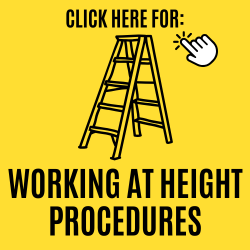
Working at Height remains one of the biggest causes of fatalities and major injuries in the UK.
It refers to any task where, without proper precautions, a person could fall a distance that may result in personal injury.
Examples include working:
- On a flat roof
- From a ladder
- From scaffolding
- At ground level, adjacent to an open excavation
- Near or adjacent to fragile materials
- From access equipment
- Anywhere else where there is a risk of falling
It is vital that any staff member working from height, or supervising work from height, is familiar with the Working at Height Procedures.
Staff should also be aware of the Work at Height Regulations 2005, which is there to protect staff and others against risks to their health, safety and well-being while working at height.
It is the employee's responsibility to:
-
Cooperate with their line manager in respect of any instruction made for the benefit of their safety or another’s.
-
Report any defective or damaged equipment to their line manager as soon as is practicable.
-
Not do anything which might put themselves or others at risk by working at height on Council premises or with Council equipment without having completed an assessment of risk and implemented suitable control measures.
-
Report any activity or defect which may endanger the safety of themself or others.
-
Use work equipment provided in accordance with training and instruction.

It is the line manager/supervisor's responsibility to:
-
Avoid work at height where possible and assess the risk where this is not possible.
-
Implement control measures in line with the risk hierarchy.
-
Ensure that a risk assessment is carried out for all work activities which involve working at height. This will include emergency rescue procedures where appropriate.
-
Ensure that where practicable, the use of ladders is avoided in favour of other forms of work at height equipment such as mobile elevated work platforms, scaffolding etc.
-
Ensure that a permit to work system is used where the working at height activity poses a particularly high risk such as that involving roof-work.
-
Ensure that those working at height are adequately trained, fit and competent to do so.
-
Ensure that work at height equipment is checked before use and formerly inspected routinely.
-
Ensure that any work at height equipment found to be unsuitable is taken out of use and either repaired or destroyed which means cutting through so it cannot be reused.
-
Ensure that records are made and retained of all equipment inspections. access specialist advice when seeking to undertake a new working at height activity.